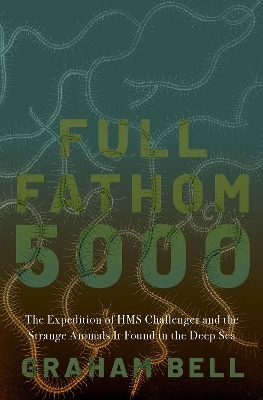
Full Fathom 5000
Oxford University Press Inc (Verlag)
978-0-19-754157-9 (ISBN)
Until the early 1870s, very little was known about the creatures lurking in the depths of our oceans. People had found a few things trapped in fishing gear or caught on the anchors of ships, but those who tried to venture to the bottom of the seafloor often died before they made it there. The first systematic investigation into life in our oceans was made during the circumnavigation of the HMS Challenger. Scientists credit this voyage as the beginning of modern oceanography, and the story of it is full of twists and turns. It led to the discovery of a whole new fauna previously unknown, which Full Fathom 5000 describes for the first time in one place for readers. In this book, Graham Bell takes readers through the voyage station by station, following the progress of the expedition and introducing some of the new and strange animals that were hauled up from the depths of the ocean and seen by human eyes for the first time. You will meet, among others, the ugliest fish in the world, flesh-eating clams, dwarf males, sea devils, and an octopus that wears lipstick.
The book begins with a description of the first attempts scientists made to explore the deep sea, leading up to the plan for a voyage around the world on the HMS Challenger. The chapters take readers from station to station, though all of the world's oceans, visiting every continent and crossing the Equator five times. Bell details what was discovered during hundreds of stops to take samples, and he describes around a hundred stations where remarkable animals were hauled from the sea. The book ends with a description of what came after the end of this journey, explaining what they did with the animals that were collected and what became of the scientists and sailors who planned the voyage and traveled together around the world.
Graham Bell, FRS, is James McGill Professor in the Department of Biology at McGill University. As an evolutionary biologist, his research interests focus on revealing the mechanism of natural selection, explaining the main features of life cycles, and investigating the maintenance of biodiversity. He helped to found in the Canadian Society for Ecology and Evolution, and he served as its first President from 2005 to 2007. His work has been recognized by his election to Fellowship in RSC (1994), Honorary Fellowship of St. Peter's College at Oxford (2003), and Fellow of the Royal Society (2016). Bell served as Director of the Redpath Museum from 1995 to 2005 and Chair of the Biology Department at McGill University from 2011 to 2016. He was President of the Royal Society of Canada from 2013 to 2015. His most recent book is The Evolution of Life (Oxford University Press, 2015).
Introduction
Part I: Before
Chapter 1: The Deep Sea
Chapter 2: Edward Forbes
Chapter 3: Two Committees
Chapter 4: The Ship and Her Crew
Part II: The Cruise
Chapter 5: Outward Bound
Chapter 6: The First Leg: The First North Atlantic Transect
Chapter 7: The Second Leg: The Sargasso Sea
Chapter 8: The Third Leg: The Second North Atlantic Transect
Chapter 9: The Fourth Leg: Into the South Atlantic
Chapter 10: The Fifth Leg: Across the South Atlantic
Chapter 11: The Sixth Leg: The Southern Ocean
Chapter 12: The Seventh Leg: The Coral Sea
Chapter 13: The Eighth Leg: The Sea of Islands
Chapter 14: The Ninth Leg: The West Pacific Ocean
Chapter 15: The Tenth Leg: The North Pacific Ocean
Chapter 16: The Eleventh Leg: The Length of the Pacific Ocean
Chapter 17: The Twelfth Leg: The Patagonian Fjords
Chapter 18: Homeward Bound
Part III: After
Chapter 19: What Happened to the Ship?
Chapter 20: What Happened to the People?
Chapter 21: What Happened to the Animals?
Index
| Erscheinungsdatum | 18.02.2022 |
|---|---|
| Verlagsort | New York |
| Sprache | englisch |
| Maße | 231 x 152 mm |
| Gewicht | 680 g |
| Themenwelt | Naturwissenschaften ► Biologie ► Ökologie / Naturschutz |
| ISBN-10 | 0-19-754157-7 / 0197541577 |
| ISBN-13 | 978-0-19-754157-9 / 9780197541579 |
| Zustand | Neuware |
| Haben Sie eine Frage zum Produkt? |
aus dem Bereich


